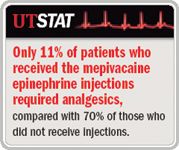Article
Intraprostatic analgesic may improve TUMT outcomes
Author(s):
Cleveland-Intraprostatic injection of mepivacaine epinephrine through a specialized catheter reduces the need for analgesia, as well as treatment time and energy consumption in patients undergoing high-energy transurethral microwave thermotherapy (TUMT) for BPH, researchers reported here.
Cleveland-Intraprostatic injection of mepivacaine epinephrine through a specialized catheter reduces the need for analgesia, as well as treatment time and energy consumption in patients undergoing high-energy transurethral microwave thermotherapy (TUMT) for BPH, researchers reported here.
Investigators from Sahlgrenska University Hospital in Göteborg, Sweden, drew their conclusions from a retrospective study of 85 men treated with the CoreTherm feedback treatment device (ProstaLund, Culver City, CA). Fifty-one patients received injections of local anesthetic containing mepivacaine epinephrine using a device known as the Schelin catheter, while the remaining patients were treated without injections.

Intraprostatic benefits
The epinephrine, said Dr. Schelin, creates an analgesic effect and decreases intraprostatic blood flow, thereby quickening the build-up of heat required to treat prostatic tissue.
"You can treat the patient almost without medication," he added. "They can often drive their car home afterward. In my practice, I've been able to reduce mean treatment times to about 11.6 minutes. It's much less cumbersome and certainly quicker for the patient."
Energy consumption in the Sahlgrenska study was 83 kilojoules for patients injected with mepivacaine epinephrine and 128 kilojoules for those not receiving the injections. Also, while all 51 patients who had injections were able to complete treatment, three of 34 patients in the control group were forced to discontinue treatment because of physical discomfort.
The Sahlgrenska team reported no side effects from mepivacaine epinephrine, and Dr. Schelin said he has not seen any in the more than 500 patients he has treated in his practice.
"I have even treated patients with unstable angina with epinephrine," said Dr. Schelin, a consultant urologist in the department of urology clinical sciences at Lund (Sweden) University who was not directly involved with the Sahlgrenska study but who presented the data on behalf of the authors. "I never observed any complications or side effects, mostly because the epinephrine is contained within the prostate and does not circulate through the body. I have a pulse oximeter, so I can govern injection speed by pulse rate.
"I've used the catheter both with and without [the epinephrine], and there was even a clear and pronounced reduction in blood flow and treatment time without the epinephrine. But if I add the epinephrine, it adds considerably. The combination is most effective."
Dr. Schelin and colleagues have been investigating the efficacy of mepivacaine epinephrine for several years in patients undergoing TUMT. In 2004, they first reported that the injections could reduce or even eliminate the increase in blood flow normally seen during treatment with the CoreTherm device (J Endourol 2004; 18:965-70).
The Schelin catheter is manufactured and marketed by ProstaLund, and is available in Europe. The company wants to make it available in the United States, as well, and expects to gain FDA approval in the next year, Dr. Schelin said.
Dr. Schelin has royalty agreements with, and is a shareholder in, ProstaLund.















